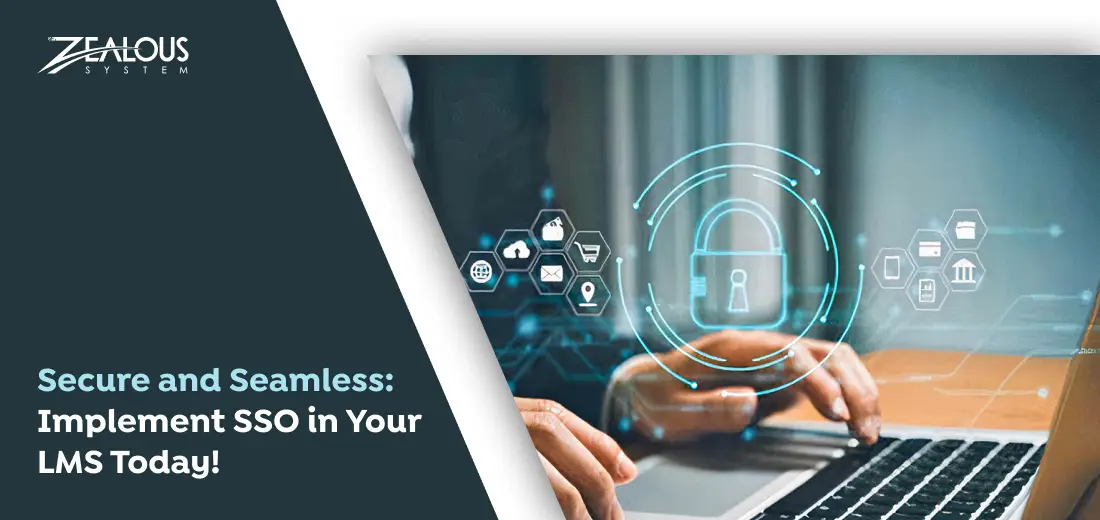
We use cookies and similar technologies that are necessary to operate the website. Additional cookies are used to perform analysis of website usage. please read our Privacy Policy
Implementing Single Sign-On (SSO) in Your LMS: The Complete Guide

Single Sign-On (SSO) has become a crucial feature in modern digital environments, including Learning Management Systems (LMS). It streamlines the authentication process for users by allowing them to log in once and gain access to multiple applications or systems without the need to re-enter credentials.
It is difficult to manage too many passwords across different platforms, which can be difficult and risky for security. Single Sign-On (SSO) solves this by centralizing authentication. It lets users log in once and easily access multiple systems, like LMS platforms, without needing to log in separately each time.
This blog provides insights into implementing SSO in all types of LMS, empowering organizations to deliver seamless learning experiences while increasing data protection and administrative efficiency.
What is Single Sign-On (SSO)?
Single Sign-On is an authentication mechanism that enables users to authenticate once and gain access to multiple applications or systems within an organization’s network. Instead of maintaining separate login credentials for each system, users authenticate centrally through a trusted identity provider (IdP), which then grants access to authorized applications, including the LMS.
Benefits of SSO for LMS for Organizations
Implementing Single Sign-On (SSO) in your Learning Management System (LMS) offers several benefits:
1. Simplified User Experience:
Users can log in once and access multiple applications and platforms without the need for separate credentials each time, reducing login fatigue.
2. Enhanced Security:
SSO makes authentication simpler by putting it all in one place. This lowers the chances of security problems with passwords, like getting hacked or tricked into giving them away, because people have fewer passwords to remember and are less likely to use ones that are easy to guess.
3. Improved Productivity:
With streamlined access, users spend less time managing passwords and logging in, allowing them to focus more on learning and tasks within the LMS.
4. Ease of Administration:
IT administrators save time and effort because they can manage all user accounts in one place, which reduces the need for handling multiple locations and decreases support tasks.
5. Integration Flexibility:
SSO supports integration with various applications and systems, enabling seamless access across different platforms integrated with the LMS.
6. Compliance and Reporting:
SSO helps organizations manage compliance better by centralizing control over how users access systems and monitoring what they do across all connected platforms.
7. Cost Efficiency:
Single Sign-On (SSO) helps organizations save money by reducing the need for multiple authentication systems and the costs to support them.
5 Steps to Implement SSO in Your LMS

Step 1. Assess Requirements and Plan
- Identify Identity Provider: Choose a suitable Identity Provider (IdP) that supports industry-standard SSO protocols such as SAML (Security Assertion Markup Language) or OAuth.
- Define Use Cases: Determine which systems and applications will be integrated with SSO, including the LMS and any other relevant platforms.
- User Mapping: Establish user mapping between the IdP and the LMS to ensure seamless user access and attribute mapping.
2. Configure Identity Provider (IdP)
- Set Up SAML/OAuth Integration: Configure SAML or OAuth settings on your chosen IdP platform.
- Generate Metadata: Obtain metadata XML files from the IdP containing endpoint URLs and encryption certificates required for integration.
3. Integrate with LMS
- LMS Configuration: Access the administration panel of your LMS and navigate to the SSO integration settings.
- Upload IdP Metadata: Upload the metadata XML file provided by the IdP to establish trust between the LMS and the IdP.
- Attribute Mapping: Map user attributes (e.g., username, email) between the IdP and the LMS to ensure accurate user provisioning and authentication.
4. Testing and Validation
- Test SSO Integration: Conduct thorough testing to ensure seamless authentication and authorization processes.
- Validate User Experience: Verify that users can log in to the LMS and access assigned resources without encountering authentication errors.
5. Deploy and Monitor
- Deploy to Production: Once testing is successful, deploy the SSO integration to the production environment.
- Monitor Performance: Monitor SSO performance and user feedback to address any issues promptly and optimize the authentication experience.
Best Practices for SSO Implementation
Implementing Single Sign-On (SSO) effectively involves following several best practices:
- Choose the Right SSO Protocol: Select an appropriate SSO protocol like OAuth, SAML, or OpenID Connect based on your security and integration needs.
- Plan for User Experience: Design a seamless login experience that is intuitive and user-friendly across different platforms and devices.
- Security Considerations: Implement strong authentication policies, including multi-factor authentication (MFA) where possible, to enhance security.
- User Education: Provide clear instructions and support documentation for users on how to access the LMS through SSO.
- Regular Audits: Conduct regular security audits and reviews of SSO configurations to ensure compliance with organizational security policies and standards.
Conclusion
Implementing Single Sign-On (SSO) in your Learning Management System (LMS) improves user experience, improves security, and streamlines administrative tasks. By choosing a suitable Identity Provider (IdP), configuring SAML or OAuth integrations, and following best practices, you can ensure a seamless authentication process that boosts productivity and engagement within your organization.
SSO is not just a convenience but a critical component of modern LMS architecture that strengthens both security and usability for administrators and users alike. For education software development companies offering LMS development services, integrating robust SSO solutions ensures a cohesive user experience and robust security framework tailored to educational institutions’ needs.
Explore Our Educational Case Studies:
We are here
Our team is always eager to know what you are looking for. Drop them a Hi!
Prashant Suthar
Meet Prashant Suthar, a Sr. Software Developer at Zealous System. With a passion for building elegant code and solving complex problems, Prashant transforms ideas into digital solutions that drive business success.
Table of Contents
×


Comments